June 17, 2025 | 19:26 GMT +7
June 17, 2025 | 19:26 GMT +7
Hotline: 0913.378.918
June 17, 2025 | 19:26 GMT +7
Hotline: 0913.378.918

Salt farmers in Bac Lieu are increasingly facing difficulties due to the low income of the salt industry. Photo: Trong Linh.
Smart Salt Community Tourism Village is associated with preserving traditional salt craft villages in Vinh Tien hamlet, Vinh Thinh commune, Hoa Binh district, and is sponsored by UNDP. The project is implemented in an area planned for concentrated salt production, with a commodity scale expected to reach 183ha by 2030.
The total salt production area in the commune is currently 118ha, with 25 households. Of which, more than 45ha of 17 households produce traditional salt. The average salt production area of 4.7ha per household is suitable for the project to orient propaganda and mobilize people to establish traditional salt production cooperatives in the community direction.
Vinh Tien is a long-standing traditional salt production hamlet in Vinh Thinh commune with 630 households (3,675 people), one of 7 salt production hamlets in the commune with an area of 80ha. In particular, the salt production area without tarpaulin still retains the traditional farming method chosen as the pilot model of the Smart Salt Community Tourism Village, which is 24.8ha of 16 households.
The UNDP has coordinated with the People's Committee of Bac Lieu province to conduct a field survey in Vinh Tien hamlet, Vinh Thinh commune.
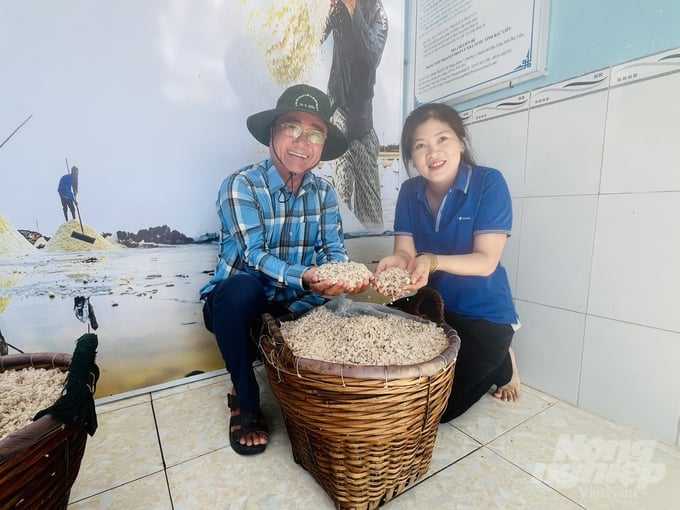
Mr. Co Tan Xuyen, Head of the Department of Agriculture and Rural Development of Hoa Binh district, highly appreciated the community tourism model of the local salt craft village. Photo: Trong Linh.
After four months of implementing the Smart Salt Community Tourism Village model in Vinh Tien hamlet, local authorities and salt farmers established common interest groups, including a production group, culinary group, amateur music group, digital transformation group, and tour guide group. At the same time, a house should be built to display artifacts about salt making, table salt products, health care salt, culinary experience services, and accommodation in the salt village.
The project implementation aims to diversify salt industry products to serve the Vietnam Salt Industry Festival - Bac Lieu 2024.
Mr. Tran Minh Duc, Chairman of Vinh Thinh Commune People's Committee, assessed that the Smart Salt Community Tourism Village model is new to the locality. In the process of implementing the model, there are still many difficulties. However, support from international organizations and the MARD has laid the foundation for local salt farmers to understand what it means to preserve salt making and develop tourism.
"The People's Committee of Vinh Thinh commune will continue to propagate and mobilize people to conserve, preserve, and promote the local salt-making profession in association with tourism development so that when mentioning Bac Lieu, tourists will think of visiting the temple salt field, at the same time, build a green, clean, and beautiful landscape environment.
Recently, the locality has also made great efforts to improve the environment, especially ensuring the best quality of the water environment," Mr. Duc shared.
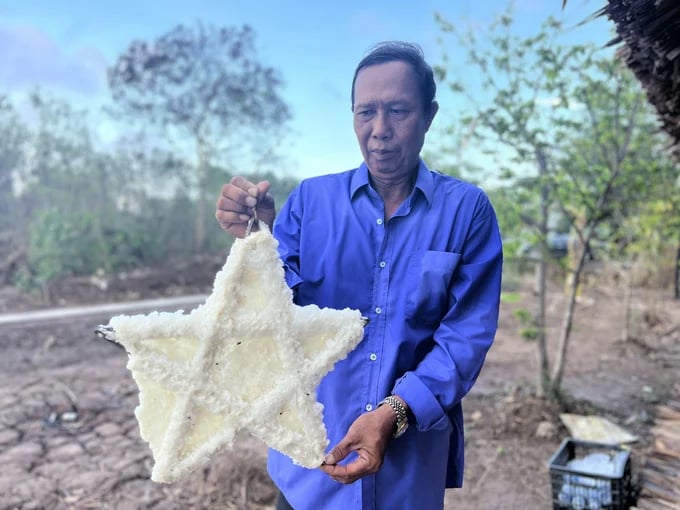
Star-shaped products are made from salt. Photo: Trong Linh.
In addition, Mr. Duc also proposed that the leaders of Bac Lieu province and the sponsoring unit support the locality in building infrastructure to maximize the value and efficiency of salt making and salt tourism, especially salt tourism. Invest in transportation infrastructure to meet the needs of tourists to access tourist villages, contributing to preserving the traditional salt-making profession.
On the other hand, consider the criteria for OCOP registration for community tourism village products, especially products from salt grains; mobilize people to improve the environmental landscape for roads leading to tourist destinations.
Hoa Binh district produces 140ha of salt, including 60ha of salt covered with tarpaulin. Due to the influence of weather, the salt area has gradually shrunk in recent years, and salt farmers have progressively switched to shrimp and artemia farming. Hoa Binh strives to create an additional 185ha of salt throughout the district in the coming time to develop and preserve the salt industry.
Dr. Ngo Kieu Oanh, agricultural tourism specialist, said that up to this point, the salt industry tourism model is still new to localities and has yet to form tourist destinations on Vietnam's tourism map. Building a salt-making experience model for tourists to visit sounds interesting, but this plan requires close coordination between scientists, tourism professionals, and the participation of local people salt people.
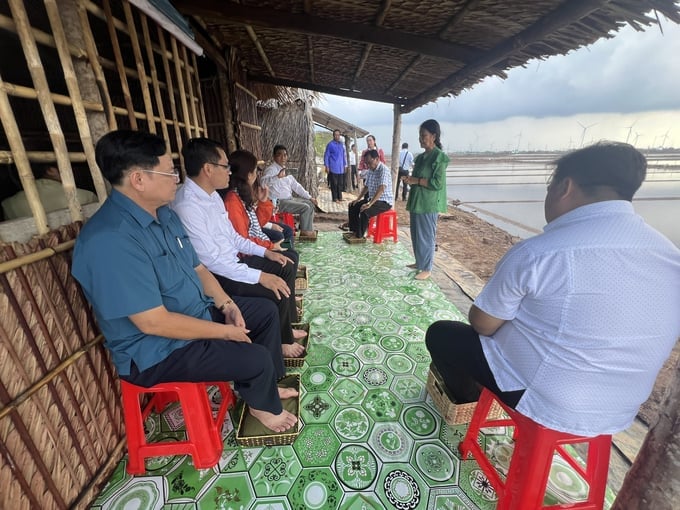
Leaders of Bac Lieu province experience salt foot bath. Photo: Trong Linh.
"It is thought that the salt-making experience model will be linked with eco-tourism and wind power fields and integrated into an eco-tourism chain. Tourists can enjoy the landscape, experience a unique traditional profession, and play the role of a salt farmer to understand more about a profession with national heritage value.
Certainly, salt fields alone cannot make tourism, but there needs to be a combination of experience and investment in adjacent models," Dr. Oanh analyzed.
Until now, Vietnam still has about ten traditional salt production localities. Manual production methods with sand drying and water dispersion technology help salt grains retain natural minerals and micronutrients with low NaCl, which is beneficial for health.
Accumulating the essence and labor force for thousands of years in some places, such as traditional salt production villages, will be attractive destinations in the agricultural tourism product development program if they meet tourism criteria.
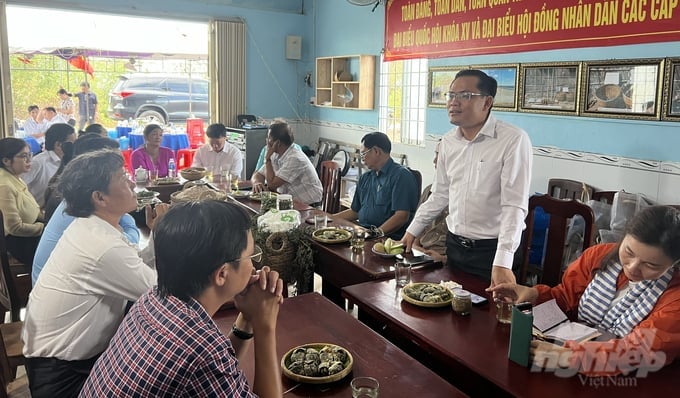
Mr. Ngo Vu Thang, Vice Chairman of Bac Lieu Provincial People's Committee, directed localities to encourage people to proactively protect the water environment to develop the salt industry and tourism. Photo: Trong Linh.
According to Mr. Ngo Vu Thang, Vice Chairman of the People's Committee of Bac Lieu province, the salt industry of Bac Lieu province has been established for a long time, famous for being Ba Thac salt. The salt industry is closely linked to the socio-economic and cultural life of the locality, especially coastal communes.
However, the salt industry is gradually disappearing due to low salt prices, salt farmers cannot develop economically and get rich compared to shrimp farming. The provincial leaders are very interested in promoting the value of salt making so that salt farmers can have a more prosperous life, make a living by making salt, get rich from salt making, and simultaneously bring the Bac Lieu salt brand to the forefront. Therefore, the Smart Salt Community Tourism Village model greatly interests provincial leaders.
Mr. Thang requested departments, branches, and localities to coordinate closely with the UNDP throughout the project implementation process with the highest determination. In addition, it strengthens equipping salt farmers with knowledge and digital transformation skills and widely propagates the value of the salt industry and the role of preserving the salt industry in association with tourism development.
In recent years, unseasonal rain has often affected salt farmers' salt production in the Hoa Binh district. Meanwhile, the current salt price is still relatively low; traditional salt (brown salt) costs VND 1,000 - 1,100 per kg, and tarpaulin salt (white salt) costs VND 1,300 - 1,500 per kg. The Smart Salt Community Tourism Village model, is expected to be effective, helping salt farmers become more attached to the salt industry.
Translated by Huong Giang
![Turning wind and rain into action: [5] Hue applies modern technology in disaster forecasting](https://t.ex-cdn.com/nongnghiepmoitruong.vn/608w/files/news/2025/06/17/z6704423696987_15fd32ffc26d590d204d520c9dac6786-nongnghiep-093938.jpg)
(VAN) In Hue city, modern technology has recently been applied in meteorological and hydrological forecasting and warning, helping to reduce the damage caused by natural disasters.
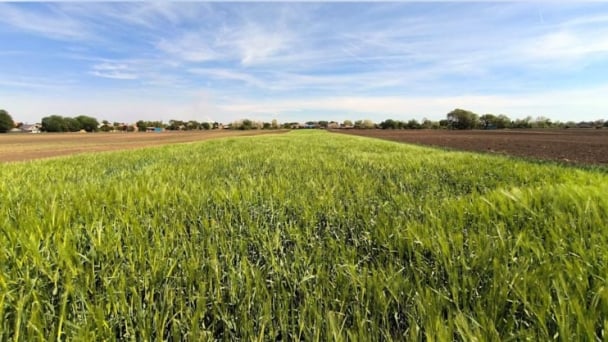
(VAN) A cutting-edge farming technique being implemented on an experimental ranch in Arizona's Sonoran Desert has already saved a billion gallons of water over five years, according to Civil Eats.

(VAN) Poultry and pig production and the environment can be boosted through enhanced water technology, according to new research.
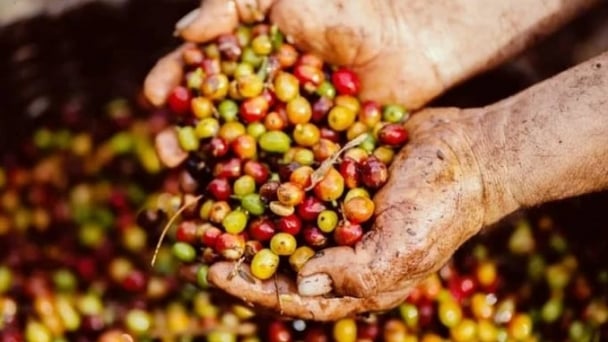
(VAN) Coffee prices on June 16, 2025 are unchanged. In Vietnam, local trading prices are holding steady, ranging around VND 112,000 – VND 112,500/kg.
![Turning wind and rain into action: [4] Bringing climate bulletins to remote and isolated areas](https://t.ex-cdn.com/nongnghiepmoitruong.vn/608w/files/linhnhp/2025/06/14/1152-z6704423696987_15fd32ffc26d590d204d520c9dac6786-nongnghiep-151141.jpg)
(VAN) The Vietnam Agriculture and Nature Newspaper interviewed Mr. Vu Thai Truong, Acting Head of Climate Change and Environment at UNDP Vietnam, to gain deeper insight into how climate bulletins are delivered to farmers.
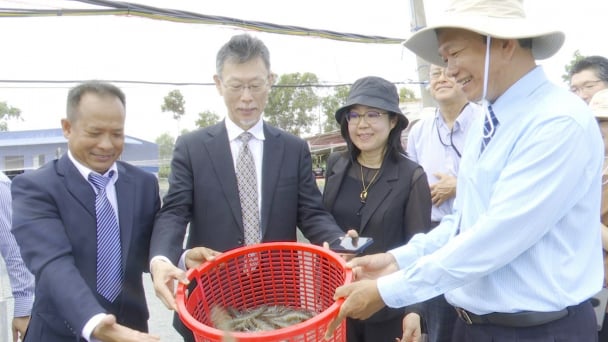
(VAN) In Tien Giang, a high-tech shrimp farm has developed a distinctive energy-saving farming model that has yielded promising results.
![Turning wind and rain into action: [3] 300.000 farmers benefit from agro-climatic bulletins](https://t.ex-cdn.com/nongnghiepmoitruong.vn/608w/files/news/2025/06/12/e5a48259d6a262fc3bb3-nongnghiep-125122.jpg)
(VAN) The agro-climatic bulletin has become a valuable tool for farmers in the Mekong Delta. After more than five years of implementation, the initiative is gradually being expanded nationwide.